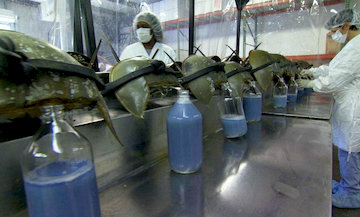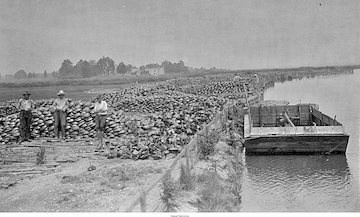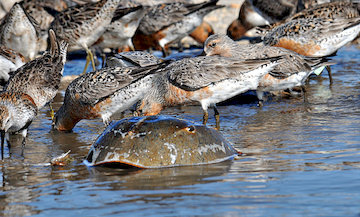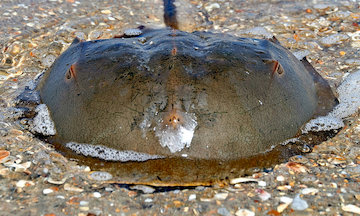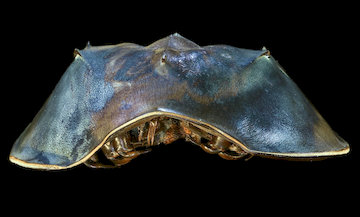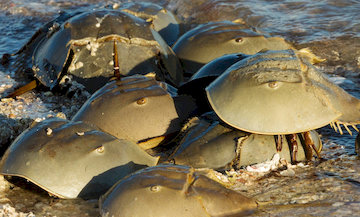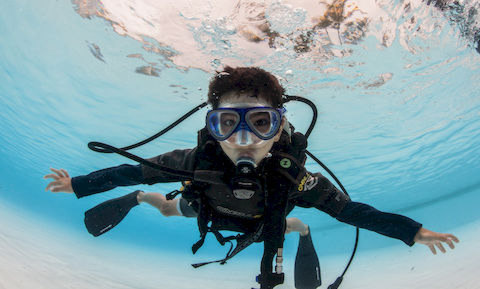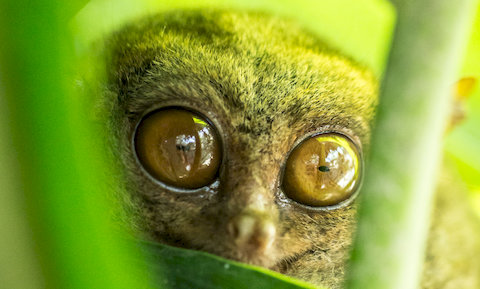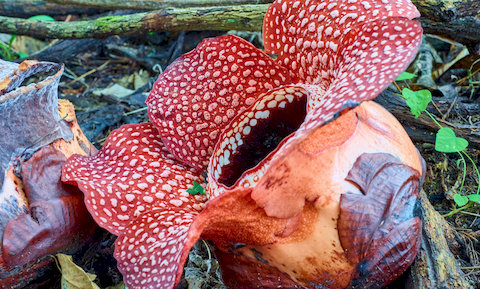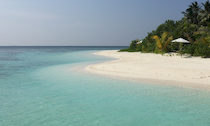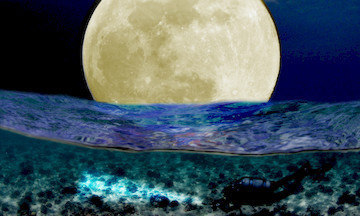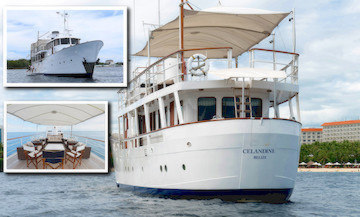Horseshoe Crabs are Living Fossils
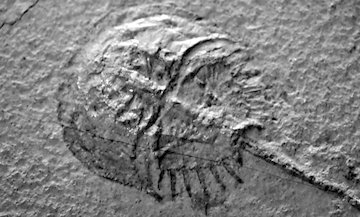 Horseshoe Crabs have been around longer than we have, they are even older than dinosaurs! They have survived and evolved through the test of time. But did you know they have blue blood, swim upside down and have about nine eyes?
Horseshoe Crabs have been around longer than we have, they are even older than dinosaurs! They have survived and evolved through the test of time. But did you know they have blue blood, swim upside down and have about nine eyes?
In this week's blog, we will be talking about the oldest animal on the planet and how they are so much more than that.
Horseshoe Crabs evolved 450 million years ago!
Yes, you read that right! Horseshoe Crabs have been living for 450 million years, that is about 200 million years before dinosaurs existed. Horseshoe Crabs, also known as "living fossils", are the oldest known animals to have inhabited this planet. Their earliest ancestor was found to have existed in the late Ordovician period, a time when the very first primitive fishes appeared.
What is a Horseshoe Crab?
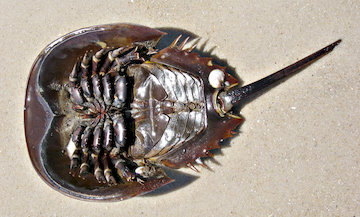 Horseshoe Crabs are marine arthropods. They got their name from their horseshoe-like shell called Carapace. Despite being called Horseshoe Crabs, they are not actual crabs but are closely related to arachnids, like spiders and scorpions.
Horseshoe Crabs are marine arthropods. They got their name from their horseshoe-like shell called Carapace. Despite being called Horseshoe Crabs, they are not actual crabs but are closely related to arachnids, like spiders and scorpions.
There are only four known species of horseshoe crabs and are likely to be found in the coasts of Southeast Asia, the Gulf of Mexico, and the U.S.A. In the Philippines, Palawan is the only place recorded where you can find them.
These alien-like creatures are one of the friendliest marine animals. Because of their intimidating and spikey tail, people think they are dangerous, but they are not. In fact, they only use their tail to steer when swimming and to turn themselves right-side up when flipped over by the waves. Picking them up by the tail is prohibited, as this injures the animal.
Why is the Blood of the Horseshoe Crab Blue?
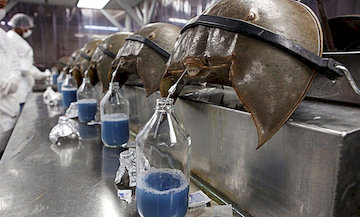 Horseshoe Crabs are known for their extraordinary blue blood. If our blood is red because of the iron present in Hemoglobin, their blood is blue because of the copper present in Hemocyanin; both Hemoglobin and Hemocyanin are the proteins that carry oxygen throughout the body. Their blue blood also contains amebocyte, a migratory cell that defends the organism against pathogens-much like how white blood cells protect vertebrates against microbes. Horseshoe crabs have no immune system.
Horseshoe Crabs are known for their extraordinary blue blood. If our blood is red because of the iron present in Hemoglobin, their blood is blue because of the copper present in Hemocyanin; both Hemoglobin and Hemocyanin are the proteins that carry oxygen throughout the body. Their blue blood also contains amebocyte, a migratory cell that defends the organism against pathogens-much like how white blood cells protect vertebrates against microbes. Horseshoe crabs have no immune system.
Their blood flows freely in their bodies, not through blood vessels (horseshoe crabs do not have veins). When the body comes in contact with bacteria, viruses, and fungi, Amebocytes (a type of bloof cell) explode to form gels around the invaders to prevent an infection as well as to immediately seal the entry where the bacteria comes in.
Amebocytes are extremely sensitive to endotoxins like Escherichia coli (E. Coli). Because of this, horseshoe blood is harvested to produce Limulus Amebocyte Lysate or LAL. LAL is used to test contamination and for sterilization of medical equipment. Since its discovery by Frederik Bang, adult horseshoe crabs spawning on coasts are collected then taken to laboratories where 30% of their blood is extracted for biomedical use.
Horseshoe crab blood is considered one of the most expensive liquids in the world. One liter costs about $15,000 or more. After getting their blood extracted, lab workers return them to the ocean. LAL is highly valuable in the biomedical industry for manufactures of vaccines, injectable drugs, medical devices and implantable medical devices (like pacemakers).
So even if you have not met or seen an actual horseshoe crab, these living fossils have saved your life one way or another.
Idiosyncrasies of the Horseshoe Crab
Can Horseshoe Crabs see through its shell?
Horseshoe Crabs have nine eyes all over their body, mostly on their carapace. They have two compound lateral eyes that they use to find potential mates and a bunch of light-sensing organs. The five light-sensing eyes on top of their carapace allow them to see both visible and UV light. On their underside, they have two ventral eyes that orient them when swimming. Horseshoe crabs also have light sensors on their tail that allow their brain to synchronize with the cycles of day and night.
Why do horseshoe crabs swim upside-down?
Horseshoe crabs swim upside-down as their way of dispersing from other animals since they are not very sociable creatures. Swimming is also their way of traveling without being bombarded with barriers that can climb on or around them. They avoid predators and cannibalism this way as well.
Most horseshoe crabs that can be observed swimming upside-down on the water are juveniles. Adult horseshoe crabs are rarely seen swimming above water because they usually spend their years feeding on the deep ocean floor.
Horseshoe crabs reproduction
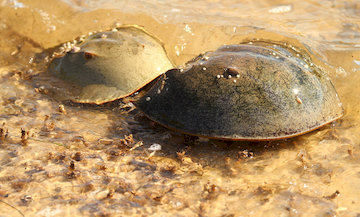 First of all: Females are a lot bigger than males, but how do you distinguish a female horseshoe crab from a male in a melee where all sizes are present?
First of all: Females are a lot bigger than males, but how do you distinguish a female horseshoe crab from a male in a melee where all sizes are present?
Take a look at its carapace or shell. In front, females have flat rounded shells, while the males have a slight curve in front on the bottom middle of their carapace to protect them when they cling on to the female.
During warmer months at full moon, adult horseshoe crabs spawn on muddy shores or wet sand. When females emerge from the water, they emit natural chemicals that signal the males for mating. A male horseshoe crab clings on to a female as she digs a hole to build their nest and lay about 60,000 to 120,000 eggs. The male then fertilizes the eggs, but different males around the area can fertilize a single nest.
Horseshoe crab eggs are one of the food sources for migrating birds and numerous reptiles and fishes. Because of this, only a few make it to larval stage. The surviving eggs hatch after two weeks or more. These larval horseshoe crabs spend about a year on tidal flats where they eat and periodically shed out their shells. As they develop, they eventually move to deeper waters until they reach sexual maturity 8 to 10 years later and come back to the shore to spawn.
Are Horseshoe Crabs endangered species?
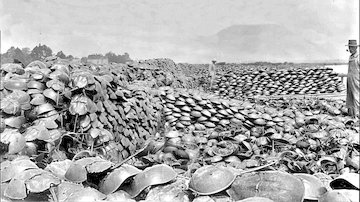 Even if Horseshoe crabs have managed to survive for almost half a billion years, they are not invincible. The most significant disruption they have come to face is our human activities. As global pharmaceutical markets grow and the biomedical industry improves, the demand for horseshoe crab blood is increasing. Other human activities include coastal development destroying their spawning sites and overharvesting them for bait.
Even if Horseshoe crabs have managed to survive for almost half a billion years, they are not invincible. The most significant disruption they have come to face is our human activities. As global pharmaceutical markets grow and the biomedical industry improves, the demand for horseshoe crab blood is increasing. Other human activities include coastal development destroying their spawning sites and overharvesting them for bait.
Researchers are already working towards finding an alternative for bait and LAL to save them from extinction. For decades, we are indebted to Horseshoe crabs for saving our lives.
Also, a huge industry was developed, up to around 50 years ago, to harvest horseshoe crabs and transform them as fertilizers. Nowadays it's the chemical insdustry which provide fertilizers.
If you are interested in a good book to read about horseshoe crab, it would be Crab Wars From William Sargent.
Horseshoe Crab Researches and References
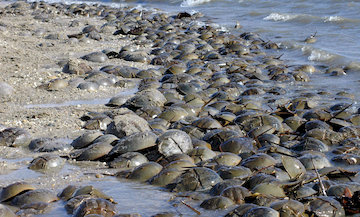 If you want to know more about horseshoe crabs, take a look at our references below.
If you want to know more about horseshoe crabs, take a look at our references below.
Below are few links we have used as references.
- Wikipedia Horseshoe crab
- Educational Resources: Horseshoe Crab
- Facts about the horseshoe crab
- Horseshoe crab's blood saves lifes
- The blood of the horseshoe crab
- Blood in the water
- Horseshoe crab Mating
- Crash: A Tale of Two Species
Last, but not Least
If you would like to receive interesting content like this in your email Inbox, subscribe to our newsletter.
In addition to our monthly newsletter, we will send you our weekly e-Bulletin with one fascinating topic, like today's article above. There will be no advertising nor sales pitch.
As always we want to thank Youtube and Wikipedia commons for some amazing images and videos on this page!
Thanks for reading, and if you wish, see you next week!
The Research and Media Team at Scotty's.
More Pictures About Horseshoe Crabs

